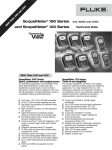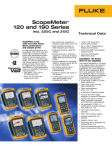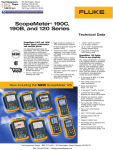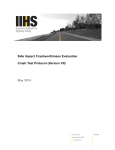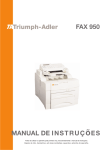Download The Fluke motor & drives presentation
Transcript
Measurement best practices for troubleshooting motors and drives Safety: Qualified Person and Motor Drive Installations - Safety • NFPA 70E Part II Safety-Related Work Practices, Chapter 1 General, Section 1-5.4.1 Qualified Persons • A qualified person: “…understands the operation of test equipment and follows all manufacturer procedures“ Conditions vary at every instance Category Ratings for test equipment CAT I- Protected electronic equipment, such as the high-voltage section of a copier. CAT II- Receptacle connected loads, such as home appliances and portable tools. CAT III- 3φ distribution, such as switchgear and poly-phase motors in fixed installations CAT IV - 3φ directly connected to utility. Test meter certification Is the meter independently verified or just “designed to meet?” All Fluke Test Equipment and Accessories with Category Ratings meets and exceeds Safety Standards. Poly phase systems in Cat III environments Do Avoid • Confirm the test instrument is rated for the use. – Drives are typically CAT III • Use test equipment you can properly operate with your PPE – Test equipment is also part of PPE • Combining CAT III instruments with lower rated accessories. • Short circuiting floating differential test points with a common ground non-isolated multichannel input device. How We Are Going to Think About This Today • Line Side • Load Side • Driven Component Basic Inverter Technology • 3-Phase AC is rectified to provide a constant DC voltage – Residual ripple and noise is filtered out • DC voltage is used by the electronic switches/gates – Controlling the on/off time of the electronic switches creates an output PWM (pulse width modulated signal), that is voltage and frequency controlled • Motor produces torque and motion controlling the mechanical load Potential Problems We Will Learn How To Test & Measure Nominal supply voltage Voltage unbalance Transients Harmonics Power factor DC Buss Voltage Unbalance Current Unbalance Output Transients Reflections Shaft Voltage (bearing current) Volt to Hertz Ratio Motor overload Single phasing Bearing failures Misalignment Mechanical imbalance Looseness Insulation breakdown What is nominal supply voltage, current, and frequency? • Nominal supply voltage, current, and frequency are the characteristics of the voltage supplied to the motor drive under normal operating conditions. • Measure using the 435 PQ meter to measure the input side of the drive, then if needed at the service entrance. – Don’t forget to check for voltage drops across connections that would indicate loose connections. Interpreting nominal voltage, current, and frequency • To test for line side under/over voltage using a 435 in the dips and swells mode for long-term measurements. – Nominal voltage should be within +/-10% – Nominal frequency should be within 0.5Hz • Diagnostic benefit: – Arrive at problem resolution faster – Avoid nuisance inverter low voltage fault circuit tripping – Avoid damage to the Drive What do we mean when we say voltage and current unbalance? • Occurs when three phase voltages or current differ in magnitude. • 2 to 3 % line side voltage imbalance has the potential to cause drive problems. Additional Learning Interpreting unbalance • Voltage unbalance: Greater than 2-3% is potentially problematic. • Current unbalance: Greater than 10% is potentially problematic. • If these situations exists, verify the Drive is capable of compensating for the unbalance by making measurements on the output • Diagnostic benefit: – Avoid tripping current overload fault protection – Avoid elevated motor temperatures Corrective Actions Symptom: Measurements: Solution: Voltage unbalance fault or improper operation Perform voltage measurements working back toward the source Look for single phase load dropping in or out Correct bad connections or wiring Verify Voltage levels, perform connection measurements back to the source Correct unbalanced voltage levels, poor connections or wiring errors Current unbalance fault or improper operation • Increase KVA of transformer or separate feed for Drive Return on investment • • Hourly cost of downtime x number of hours + Cost of replacement equipment = $ ??? Test equipment cost = $7,500 • Example: $5,500 per hour x 4hrs + $1,200 motor cost = $23,200 Fluke-435 Input Power Summary • As little as 2 to 3% voltage unbalance on the input to a motor drive inverter can cause voltage notching and excessive current to flow in one or more phases. • 10% current unbalance and you can start to have problems • Nominal voltage should be within 10%, plus or minus, of the intended voltage. • Typical power distribution standards allow for deviations no more then 10%, but standards vary by country and location. • Nominal frequency should be within 0.5Hz of specification. • This potential problem is most likely to occur when on backup power since generators can shift in frequency. What are transients? • Transient - temporary unwanted voltage on the AC line inputs. – – – – Wide range of waveforms, amplitudes, and durations Constant - are easier to locate Intermittent - are difficult since they can occur randomly Drives, cabling and motors can suffer damage Additional Learning Interpreting transients • Transients above nominal voltage are potentially problematic. – Check with your VFD user manual for exact specifications. • Diagnostic benefit: – Prolong Drive and motor life – Avoid tripping overvoltage circuits – Identifying transients helps isolate building faults Corrective Actions Symptom: Measurements: Solution: Voltage high/low fault, improper operation or Drive failure Perform transient measurements working upstream toward the source and downstream towards other loads to find the source Correct bad connections, wiring or ground Repair or replace improperly operating loads Installation of surge suppressor or transient arrestor • Return on investment • • Hourly cost of downtime x number of hours + Cost of replacement equipment = $ ??? Test equipment cost = $7,500 Fluke-435 What are harmonics? • Harmonics are multiple frequency components of the fundamental waveform. – E.g., a third harmonic of 60Hz is 180Hz. The fifth harmonic of 60Hz is 300Hz. – Harmonics create additional heat in the system and components. – They serve no benefit Additional Learning Interpreting harmonics • Voltage THD (Total Harmonic Distortion) greater than 5% is potentially problematic. • Diagnostic benefit: – Avoid repair costs from excessive harmonic distortion – Avoid motor and transformer overheating – Avoid voltage distortion Corrective Actions Symptom: Measurements: Solution: Drive faults of current, voltage and overheating Perform Harmonic and THD measurements working upstream toward the source and downstream towards other loads to find the sources Installation of harmonic filters at main contributing circuits or loads Distortion of voltage and/or current waveforms Overheat of transformers, connections, wiring, system components (breakers etc.) and loads Correct improper operation of loads Redistribute single phase loads among the three phase to reduce the harmonic effects High phase & neutral currents • Return on investment • • Hourly cost of downtime x number of hours + Cost of replacement equipment = $ ??? Test equipment cost = $7,500 Fluke-435 What are the thermal signatures of key components in the motor drive input? • A thermal signature indicates the apparent heat emitted from the surface of an object. • Thermal signatures can highlight temperature hotspots or deviations from normal operating conditions. Interpreting the thermal signatures of key components in the motor drive input • Use a thermal imager to scan the component and look for irregular and nonuniform thermal patterns or anomalies. • Diagnostic benefit: – Identify hot spots, cold spots, or unexpected conditions faster and safer than contact measurements alone. – Arrive at problem resolution faster. – Avoid damage to the motor drive. What is power factor? • Energy is the capacity to do work. • Power factor is the ratio of the active power(W) used in an AC circuit to the apparent power (VA) in the circuit. – PF = Watts / Volts-Amps Additional Learning Interpreting power factor • A power factor of less than 1 indicates that the circuit is not operating at full efficiency. • A measurement of less than 0.9 indicates a potential problem. – Power factor should be measured for at least 24 hours anytime changes are made to the power system. Power factor • A purely resistive load (ex. a heater) has a power factor of 1.0 • Inductive loads such as motors, transformers, and high-intensity lighting introduce reactive power into a power system and typically cause lower power factors. • A measurement of less than 0.9 may incur financial penalties and require improvement due to contractual obligations with the utility. • A measurement from 0.9 to 1 indicates a well-behaved motor drive. • The power factor of a motor will vary depending on it’s loading, typically the closer to full load the better the power factor. • Circuits may have to be derated where a consistently low power factor occurs. • When thinking about low power factor think low efficiency – it’s costing more to run your equipment as the overall losses will be higher. • Diagnostic benefits: • Identifying and correcting low power factor saves money on utility bills • Prevent voltage drops and overheating by identifying capacity restrictions Drive Line Side Measurements • Recommendations: – Fluke 435 Power Quality Analyzer • With few simple connections, the Fluke-435 can completely verify the condition of the power supply to the drive – – – – – – – Apr-11 Nominal Voltage Unbalance Voltage Inrush Capture Transients Harmonics Power and Energy Logging Fluke Motors & Drive - Hands-on Excercises Additional Learning 26 Fluke – 435 Power Quality Analyzer • Capabilities – Troubleshoot real-time: • Analyze the trends using the cursors and zoom tools. – Highest safety rating in the industry: • 600 V CAT IV/1000 V CAT III rated for use at the service entrance. – Measure all three phases and neutral: • With included four iflex® flexible current probes with thin flex design to fit into the tightest places. – Automatic trending: • Every measurement is always automatically recorded, without any set-up. – Automatic transient mode: • Capture 200 kHz waveform data on all phases simultaneously up to 6 kV. Fluke – 435 Power Quality Analyzer • Capabilities (continued) – System-monitor: • Ten power quality parameters on one screen according to EN50160 power quality standard. – Logger function: • Configure for any test condition with memory for up to 600 parameters at user defined intervals. – View graphs and generate reports: • with included analysis software. – Energy loss calculator: • Active and reactive power measurements, unbalance and harmonic power are quantified to pinpoint true system energy losses in dollars Fluke – 435 Power Quality Analyzer • Capabilities (continued) – PowerWave data capture: • Capture fast half-cycle RMS data and waveforms to characterize electrical system dynamics (generator start-ups, UPS switching etc.). – Waveform capture: • Capture 120 cycles (60 Hz) of each event that is detected in all modes, without set-up. – Easy to use, powerful and complete • Charge the battery, load the software and you are ready to go Input Power – Summary • By checking the input power first: – You can rule out issues that might affect the motor drive or breaker circuits – This can save you time and lead to a faster problem resolution. – In addition, by identifying over or under voltage conditions, you can avoid nuisance tripping of drive fault circuits, and eventual damage to the motor drive itself. • • • How much time did you spend trying to fix these kind of problems in the past? How much time/money do you think you can save by using the a Thermal imager or a 435 PQ analyzer? • Arrive at problem resolution faster. • Avoid nuisance inverter low voltage fault circuit tripping. • Avoid damage to motor drive. Next steps – Talk to your distributor or Fluke representative about scheduling an on site demo or getting more product information Introduction to drive output measurements What is DC Bus? • DC Bus functions as a voltage buffer • Direct current (dc) voltage derived from AC rectifiers • Provides constant energy supply to switching circuit • DC bus voltage is ~1.414 x the RMS line voltage • 480 Vac drive, the DC bus should be ~ 678 Vdc (Use a 1000v rated meter) • Too low or noisy causes malfunction of drive output due to reduced energy available to the output devices Measuring the DC Bus • Recommendations: • Fluke Scopemeter • Fluke–87 V • Exceeds safety standard 1000 V Cat III and 600 V Cat IV, • Low pass filter, Peak capture, Min/Max recording to name a few features Corrective Actions Symptom: Measurements: Solution: Voltage level high - Perform min/max recording of Correct Drive’s AC input voltage low Bus fault, the bus DC voltage and AC improper operation ripple/noise Improper operation rectifiers or Drive failure or filtering circuits Confirm Drive rating is compatible with the motor and load • Return on investment • • Hourly cost of downtime x number of hours + Cost of replacement equipment = $ ??? Test equipment cost = $3,500 Fluke-190 -II Measuring voltage unbalance • Measure the voltage on each terminal at the drive output • Next check the voltage at the motor terminals • Any unbalance could be problematic for the motor Use a Multimeter or ScopeMeter with a low-pass filter function (Vpwm) to measure the effective voltage to the motor. Calculating voltage unbalance Example % Voltage (V) unbalance = (Max deviation from average V/average V) x 100 (The same calculation is used for current unbalance) Interpreting voltage unbalance measurements • Unbalance greater than 3% is problematic and will result in excessive motor winding heat. • Possible causes of voltage unbalance on the drive output are: – One of the phase drive circuits is only partially conducting – There is a voltage drop between the ASD’s output and the motor terminal due to a poor connection Measuring current unbalance • Use a Fluke 4 channel (190-204/S) ScopeMeter with a current clamp on all three drive output terminals to measure the current draw on each terminal. • 10% unbalance should be the maximum • Diagnostic benefits: – Extend motor life – Avoid catastrophic failure – Reduce downtime and economic losses Corrective Actions Symptom: Measurements: Voltage/Current level Perform phase voltage high - low output fault measurements (will influence current balance) Elevated motor temperatures Perform phase current measurements Measure motor temperature Improper operation or Drive failure • Measure winding resistance and insulation Solution: Disconnect the load on the motor and confirm balance changes – improvement over load probable cause Disconnect the motor and confirm Voltage balance changes – improves motor perform then winding and insulation measurements Confirm Drive rating is compatible with the motor and load Return on investment • • Hourly cost of downtime x number of hours + Cost of replacement equipment = $ ??? Test equipment cost = $3,500 Fluke-190 -II What are output reflections? • Occur as a result of impedance mismatch or change in the current transmission path. • Show up as spikes on the lead and/or falling edges of the wave shapes on an oscilloscope display. • To use an analogy, consider what happens to a garden sprinkler when the flow of water is momentarily changed by someone or something stepping on the rubber pipe. • The pressure at the sprinkler head changes peaking as the built up pressure is released. Measuring output reflections • Overvoltage reflections can only be measured with an oscilloscope • A four channel version is recommended. • Attach the scope to motor terminals • Typically we can not detect transients with a digital multimeter because the duration is extremely short, too fast for the capture time of a typical multimeter. Interpreting output reflection measurements • Reflections > 50% of nominal voltage are problematic and can be 2 to 3 times the DC bus voltage. • Fast switching DC voltage from the IGBT (dV/dt). • Reflections of the PWM signal are a result of a too long cable. • Make sure the level does not exceed the motor and cabling insulation ratings. Interpreting output reflection measurements • Note the amplitude base and the faster time base. • Screen shot on the left has faster time base • Diagnostic benefits: • • • Prolong Drive and motor life Avoid tripping overvoltage circuits Reduce potential of cable and winding insulation breakdown Corrective Actions Symptom: Measurements: Solution: Noisy motor Perform phase voltage measurements Peak to peak Shorten cabling between the Drive and the motor or Install low pass filter, series line reactors or RCimpedance matching filter between the Drive and motor Drive output voltage and current faults Shorten life of Drive, cabling, bearings and motor Measure motor temperature Measure winding resistance and insulation Vibration test for bearing health Rewind motor windings and cabling with higher insulation rating if reflections not reduced Replace bearings • Return on investment • • Hourly cost of downtime x number of hours + Cost of replacement equipment = $ ??? Test equipment cost = $3,500 Fluke-190 -II What is shaft voltage? • • High frequency PWM voltages are coupled to the stator and shaft. When shaft voltage exceeds the insulating capability of the bearing, current flows through the bearing. – Bearing destruction within a few months of motor operation. • Look for shaft voltage higher than 8 volts. – Breakdown voltage creates higher bearing flashover currents, which causes increased damage to the bearings in a shorter amount of time. – Solutions include a shaft grounding device (the most common), conductive grease or insulated bearings. • Diagnostic benefits: – Extend bearing life – Avoid downtime and associated economic losses What is volt per hertz ratio? • The ratio of voltage to frequency determines the amount of torque produced by an AC induction motor. • By keeping this ratio constant the magnetic field inside the motor is kept at a constant level which results in a constant torque. Measuring volt per hertz ratio • Use Fluke Scopemeter with Vpwm function. • Vpwm: Replicates the amplitude of the fundamental frequency • Use current clamp to measure the frequency • Fluke Scopemeters can simultaneously display the frequency of the pulse width modulation (PWM) output and a voltage comparable to the motor nameplate rating. Interpreting volt per hertz ratio measurements • If V/Hz ratio is correct but the speed is off, check the drive program. • An incorrect volts-per-hertz ratio can create a variety of problem. • • • • • High: motor will overheat. Low: Loss of torque. Unstable: rough running motor and loss of torque. Unstable frequency: Varying speed of the motor. Fluctuating in tandem: potential loss of torque. • Diagnostic benefit: • • Reduce excessive heating Prevent loss of torque Fluke 190 Series II ScopeMeter •Capabilities – Combines the power of a high performance oscilloscope and paperless recorder in an easy to use test tool – Extend your troubleshooting capabilities by visually inspecting signals amplitude, time, shape and disturbance or distortion characteristics – Connect-and-View™ triggering for intelligent, automatic triggering on fast, slow and even complex signals • Gives you an instant stable display – Automatic capture of the last 100 screens to find one-time anomalies • No user setup required Fluke 190 Series II ScopeMeter • Capabilities (continued) • Four isolated floating channels » Safely perform differential or floating measurements on multiple signals simultaneously up to 1000 V • TrendPlot records up to 16 days to catch intermittent faults • ScopeRecord helps you capture glitches as short as 8 ns • CAT III 1000 V/CAT IV 600 V ratings » Safely perform measurements on equipment that is permanently installed in plant electrical distribution systems Fluke 190 Series II ScopeMeter •Capabilities (continued) – Direct storage on internal memory • 15 waveform memory locations internal – Stores Scope-trace waveform data (4 traces each), screen-copy and corresponding setup – Setup storage allows for instant configuration of tests – Isolated USB host port for direct data storage to a USB memory device and easy PC communication – USB memory devices expands storage and allows for personal library of measurement and setups – Up to 7 hours of battery operation – Rugged and shock proof What are the thermal signatures of key components in the motor drive output? • Thermal imagers can be used to scan the motor drive output to identify hot spots or abnormal heating conditions • Use a thermal imager to scan the component and look for irregular and nonuniform thermal patterns or anomalies Interpreting the thermal signatures of key components in the motor drive output Motor Overheating Increase over Maximum Temperature Rating Insulation Life Reduced by +10°C (18°F) -50% +20°C (36°F) -75% +30°C (54°F) -88% • High resistance connections, phase imbalance and current overload contribute to variations in thermal signatures • Motor overheating can be caused by winding insulation and cooling problems • Diagnostic benefit: – Identify hot spots or anomalous conditions faster – Avoid catastrophic failure – Extend motor life Fluke Thermal Imagers •Capabilities – Enhanced problem detection and analysis with IR- Fusion Technology – only from Fluke • Combines the power of infrared images with visible light images on the same display – Optimized for field use in harsh work environments • Withstand a 6.5 foot drop • IP 54 rated for dust and water – Delivers clear, crisp images to find problems fast • Multiple measurement capabilities • Easy to use with simple navigation through menu driven selections • IR-OptiFlex focus system and manual focus – Smartview Software • Easy, high-performance analysis and reporting Fluke Thermal Imagers • Ti100 Series – Lightest, rugged, easy to use thermal imagers • P3 Series – Proven, Practical, Performance • Ti Series – Rugged tools for everyday use • FlexCam® Series – Feature packed for demanding applications PQ / Scope Measurements Overview • • • • • • 3% Voltage Unbalance 10% Current Unbalance .5% Frequency 10% Voltage Nominal Supply 5% THD .9 Power Factor 7/17/2014 56 Drive measurement – Summary • Now you know how to check the output side of the drive and the tools needed – These tools help rule out issues that might be affecting the output side of the drive – Saving time and money. • How much time did you spend trying to fix these kind of problems in the past? • How much time/money do you think you can save by using a ScopeMeter and a thermal imager? • Next steps – Talk to your distributor or Fluke representative about scheduling an on site demo – Getting more product information or go to Fluke.com to learn more about using a ScopeMeter to troubleshoot drives and control electronics. • Arrive at problem resolution faster. • Prolong motor drive and motor life. • Reduce potential of winding insulation breakdown • Avoid tripping overvoltage circuits. Driven Components • Vibration testing Why vibration testing? • Early Indicators of Machine Health – – – – Alignment - In motor drivetrains, it is how well centerline of two coupled shafts coincide Bearings - Operating at reduced efficiency Imbalance - Occurs when center of mass is not on center “heavy spot” Looseness - Excessive clearance between parts or mountings that need tightening Fluke 810 Vibration Tester • With the Fluke 810, vibration testing is within reach – It’s easy to use – Provides answers when you need them – Includes everything you need to get started immediately • You will understand – Root cause of faults and fix it right the first time – Severity of failures and prioritize your repairs – Location of faults and focus your repair work • It requires minimal upfront investment…but the Return on investment is significant Fluke 810 Vibration Tester – ease of use Fluke 810 Vibration Tester • Capabilities – On-board diagnosis and location of mechanical faults: • Bearings, looseness, misalignment, unbalance and other (nonstandard faults) – Fault severity scale • Slight, Moderate, Serious, and Extreme – Prioritized repair recommendations – Diagnostic details include • cited peaks and vibration spectra – Context Sensitive Help – Data export for more detailed Analysis – Laser tachometer for accurate machine running speed – 100 mV/g TEDS tri-axial accelerometer – Data storage and tracking with VIEWER Software – 8 hours battery life, rechargeable Driven Component Measurement Tests • IRT (Insulation Resistance Tester) • Unbalance – DMM – Clamp • Mechanical Balance (Vibration tester) • Alignment (Alignment tool or Vibration tester) • Looseness (Vibration tester) • Bearing Wear (Vibration tester) • Temperature (Infrared gun or Thermal Imager) Driven Component Summary • If not diagnosed and corrected, alignment, bearings, imbalance and looseness can accelerate wear of motors and other mechanical equipment. • They can also create catastrophic failure, safety problems, and damage close proximity equipment. • How much time did you spend trying to fix these kind of problems in the past? • How much time/money do you think you can save by using a Vibration analyzer like the 810? • Next steps • • Talk to your distributor or Fluke representative about scheduling an on site demo Getting more product information go to Fluke.com to learn more about using a Vibration tester to troubleshoot mechanical equipment • Reduce mechanical wear • Avoid overheating and failure. • Improve efficiency, reduce power consumption • Reduce downtime and economic losses. 64 Lecture Conclusion Covered drive tests and measurements line side to load side. Input Power Quality with Fluke-435 Drive & Drive output with Fluke-190 Series-II ScopeMeter Core temperatures with Fluke Thermal Imagers Mechanical Vibration with Fluke 810 Diagnostic benefits of Input Power • Measuring nominal supply voltage, current, and frequency • • • Arrive at problem resolution faster Avoid nuisance inverter low voltage fault circuit tripping Avoid damage to the Drive • Unbalance measurements • • Avoid tripping current overload fault protection Avoid elevated motor temperatures • Transients • • • Prolong Drive and motor life Avoid tripping overvoltage circuits Identifying transients helps isolate building faults • Harmonics • • Input Power Quality with Fluke-435 Avoid repair costs from excessive harmonic distortion Avoid motor and transformer overheating • Power Factor • • Identifying and correcting low power factor saves money on utility bills Prevent voltage drops and overheating by identifying capacity restrictions Diagnostic benefits of Drive & Drive Output • Measuring voltage unbalance • • • Avoid tripping current overload fault protection Avoid elevated motor temperatures Avoid causing current unbalance • Current unbalance measurements • • • Avoid tripping current overload fault protection Avoid elevated motor temperatures Current unbalance can lead to burnt windings • Measuring output reflections • • • Prolong Drive and motor life Avoid tripping overvoltage circuits Reduce potential of cable and winding insulation breakdown • Volts per hertz ratio measurements • • Reduce excessive heating Prevent loss of torque Drive & Drive output with Fluke-190 SeriesII ScopeMeter Diagnostic benefits of Motor & Drive Train • Vibration testing • Diagnostic benefit: • Early Indicators of Machine Health • • • • Alignment Bearings Imbalance Looseness • Provides: • • • Root cause of faults Severity of failures Location of faults Driven Component Fluke-810 Vibration Tester Diagnostic benefits of Thermal Imaging • Diagnostic benefit: – Identify hot spots, cold spots, or unexpected conditions faster – Arrive at problems resolution faster. – Avoid damage to the motor drive, motor, driven components, and connections – Avoid catastrophic failure – Extend motor life Fluke-125 Thermal Imager Hands-On Stations Be Safe! Refer to your seminar packet/student reference materials







































































